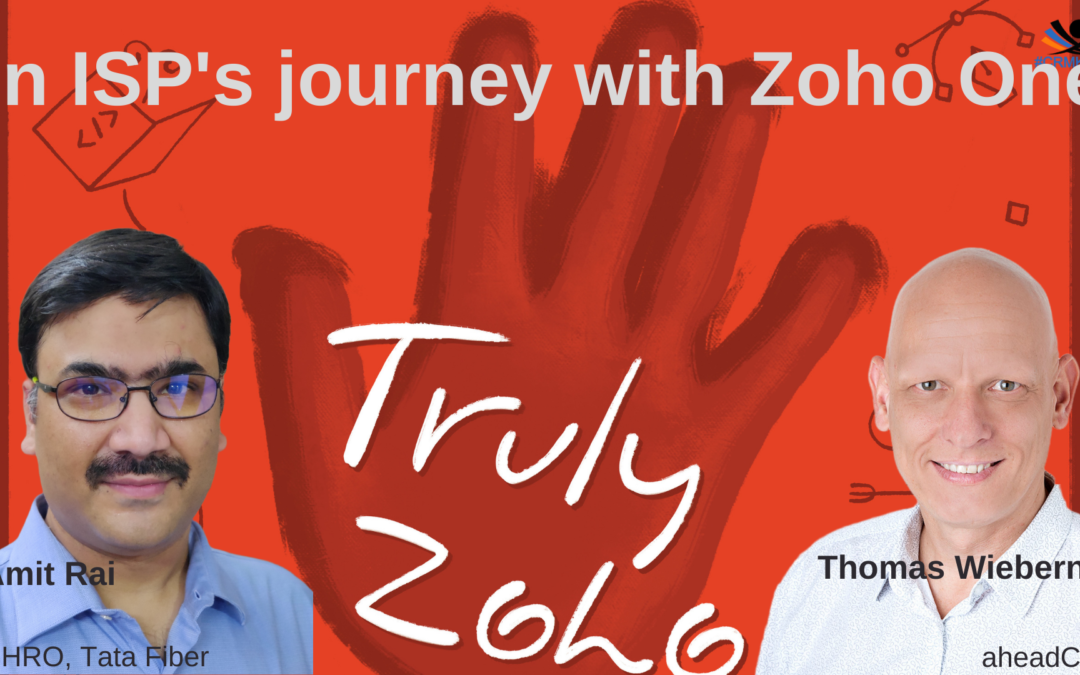
by twieberneit | Mar 21, 2023 | Blog, Case Study |
During the truly remarkable (pun definitely intended) TrulyZoho event I, of course had the chance to talk to some customers. One of these customers was Amit Rai of Tata Fiber, an Indian ISP. As the name suggests, Tata Fiber provides internet services through fiber. The company was founded in 2016 and started commercial rollout in 2018, so is a kind of start-up. Amit is the Chief HR Officer of Tata Fiber, but also led their digital projects and is now heading business development for the company. He happily agreed to a conversation about the relationship between Zoho and Tata. The following article is based on the conversation with Amit. TL&DR If you do not want to read and prefer a video, you can also listen in to the conversation. The original problem at hand We started in 2019 with HR management, in particular with Zoho people, as a solution in this functional area was needed. The implementation gave us confidence in Zoho and our implementation partner. From there on we implemented additional Zoho apps. We started on the call center as the agents needed to work with and toggling between a multitude of screens when working with a customer to resolve issues. The agents in parallel needed to talk to the customer, making sense. Of course, the quality of the conversations suffered from this and the conversations got longer. Longer conversations are a cost to us. Why Zoho? The original implementation gave us a good confidence in Zoho. This was not only because of the product but also because of the responses from the Zoho organization and the implementation team, the...

by twieberneit | Mar 16, 2023 | Analysis, Blog |
The hype around generative AI, in particular ChatGPT is still at a fever pitch. It created thousands of start-ups and at the moment attracts lots of venture capital. Basically, everyone – and their dog – jumps on the bandwagon, with the Gartner Group predicting that it is getting worse, before it is going to be better. According to them, generative AI is yet to cross the peak of inflated expectations. Gartner Hype Cycle for Artificial Intelligence, 2022; source Gartner There are a few notable exceptions, though. So far, I haven’t heard major announcements by players like SAP, Oracle, SugarCRM, Zoho, or Freshworks. Before being accused of vendor bashing … I take this is a good sign. Why? Because it shows that vendors like these have understood that it is worthwhile thinking about valuable scenarios before jumping the gun and coming out with announcements just to stay top of the mind of potential customers. I dare say that these vendors (as well as some unmentioned others) are doing exactly the former, as all of them are highly innovative. Don’t get me wrong, though. It is important to announce new capabilities. It is probably just not a good style to do so too much in advance, just to potentially freeze a market. This only leads to disappointments on the customer side and ultimately does not serve a vendor’s reputation. For business vendors, it is important to understand and articulate the value that they generate by implementing any technology. Sometimes, it is better to use existing technology instead of shifting to the shiny new toy. The potential benefits in these cases simply do not outweigh the disadvantages, starting...

by twieberneit | Mar 2, 2023 | Blog |
The past 9 months have seen quite a rollercoaster in the tech industry. We have seen staggering profits, we continue to see stock buybacks, we have seen consolidation, mergers and acquisitions – and we have seen mass layoffs. Few of them were well handled or communicated. Even fewer showed any sign of executives taking accountability besides stating that they made mistakes during the pandemic and that they feel sorry for what they need to do now. They had simply over-hired and now need to take corrective action to stay on a ‘growth path’. One of these executives arguably took the prized company culture of regarding the employees as family to grave. What do these layoffs have in common? They were initiated to please the capital markets, i.e. shareholders and venture capitalists. The idea behind this is that layoffs is the fastest way to solve or avoid impending financial problems. However, there is mounting scientific evidence that this idea is a myth, as e.g., expressed here, here or here as summaries. There is often no financial benefit, even not after 3 years; instead, some scientists look at these layoffs as “the result of imitative behaviour [that is] not particularly evidence based” and that there are other, better ways that businesses can pursue. But, as Raju Vegesna says “customers are inherently loyal, employees are inherently loyal, investors are not. Yet, businesses are most loyal to this least loyal group of stakeholders”. Ouch! One of these better ways And, indeed, one company that pursues other avenues is Zoho. Zoho CEO and co-founder Sridhar Vembu pledged that there will be no layoffs for economic reasons, no matter what. But this isn’t...

by twieberneit | Feb 15, 2023 | Blog |
Now, that we are in the middle of – or hopefully closer to the end of – a general hype that was caused by Open AI’s ChatGPT, it is time to reemphasize on what is possible and what is not, what should be done and what not. It is time to look at business use cases that are beyond the hype and that can be tied to actual business outcomes and business value. This, especially, in the light of the probably most expensive demo ever, after Google Bard gave a factually wrong answer in its release demo. A factual error wiped more than $100bn US off Google’s valuation. I say this without any gloating. Still, this incident shows how high the stakes are when it comes to large language models, LLM. It also shows that businesses need to have a good and hard look at what problems they can meaningfully solve with their help. This includes quick wins as well as strategic solutions. From a business perspective, there are at least two dimensions to look at when assessing the usefulness of solutions that involve large language models, LLM. One dimension, of course, is the degree of language fluency the system is capable of. Conversational user interfaces, exposed by chatbots or voice bots and digital assistants, smart speakers, etc. are around for a while now. These systems are able to interpret the written or spoken word, and to respond accordingly. This response is either written/spoken or by initiating the action that was asked for. One of the main limitations of these more traditional conversational AI systems is that they are...

by twieberneit | Jan 30, 2023 | Blog |
In 2022, the Forrester CX Index dropped for the first time in years, with nearly twenty percent of US brands seeing a drop in customer experience. Towards the second half of 2022, an increasing number of companies fear a recession and put their spending under scrutiny. At the same time, companies still struggle to link CX projects to business outcomes and their metrics, let alone to financial metrics. In addition, Forrester predicts that also in the next few years, CX teams will lack critical design, data and journey skills. In parallel, there is an increasing number of companies that deliver software and/or services that are intended to help businesses improve their CX. In the past years, CX has established itself as a whole new category of software. Many a company has repositioned itself to become a CX vendor, examples including all major CRM vendors, but also call center specialists like Genesys. And, naturally, a good number of these new CX actors got – and get – acquired by bigger fish. A very good example of this trend is the decrease in the number of independent journey orchestration vendors or the concentration of chatbot vendors into conversational AI vendors. Of course, this list cannot be exhaustive in any case. So, clearly vendors are betting big on CX being a growth market, while their clients still struggle to justify the expense into CX. This leads Forrester to predict that twenty percent of CX programs will be stopped and the teams correspondingly disbanded and probably be merged into other parts of the organization. Why is this? Although the true differentiator of every business nowadays is not product,...






